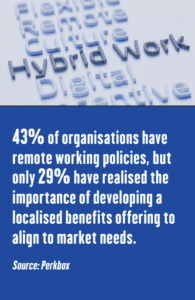The combination of onsite, hybrid, and remote work arrangements makes the issue of employee pay even more complex.
By Simon Kent
A recent study by global benefits and rewards platform Perkbox found that almost two-thirds of businesses (62%) are planning to increase the number of remote staff they hire outside of their main country of operations over the next 12 months. Clearly, businesses are targeting the best talent to work for them, wherever they may be, but alongside this, HR must ensure that remuneration and reward policies keep pace. Flexible hours and dedicated remote working policies are being put in place (reported by 43% and 42% of Perkbox respondents) but less than one in three (29%) have realised the importance of developing a localised benefits offering to align to market needs.
The combination of hybrid arrangements alongside remote working makes the issue of employee pay more complex. Add into this recent economic trends and HR can be forgiven for being uncertain as to how much they should be offering any particular candidate for a particular post and how they should arrive at a figure. “It’s not as straightforward as simply transferring the ‘home’ salary to another location,” says Ema Boccagni, commercial director EMEA at global mobility expert ECA International (ECA). “With employees deemed to be working for an entity that is based in a different location to the one they live in, companies need to be compliant with laws in both locations.”
Boccagni suggests building remuneration from the ground up, starting by meeting the minimum wage requirements of the ‘host’ country. This alone may not be straightforward as pay can still depend on the type of visa the employee is on and any legal requirements in the host country – issues such as mandatory bonuses or overtime pay, for example. Having made these considerations, the salary can then be compared with other positions in the organisation. Boccagni says for virtual assignments – when a company asks a specific employee to perform a role remotely – the aim should be to ensure the employee is no worse off than they would be if they were performing that same role in their home location.
But even this isn’t a cut-and-dried process. Consideration may still be made for relative buying power and housing costs, and employers may still need to make provisions for exchange rate fluctuations.
In some scenarios, employees may also be liable to pay tax and social security contributions in two locations, or the tax rate might be more in the country which provides the source of their income. Consequently, to deliver the same net salary, the company may need to meet additional liabilities.
“Businesses also need to consider their responsibilities, should an employee be unable to contribute to social security in their home location, and whether they will compensate for any loss of retirement or other benefits over the course of the assignment,” adds Boccagni. Global HR and business services company Remote currently employs more than 900 people in more than 65 countries. According to Nadia Vatalidis, VP of people at the company, this means that at any given time, the business will have people working in areas that have both very high costs of living as well as very low costs of living.
Regardless of location the business starts from the position of hiring the best person for the role. And as Vatalidis suggests one rule still applies: Companies have to pay well to hire great people.
Vatalidis recommends the use of data as a starting point and her company uses geo ranges as a middle-ground between flat global 
Pay also needs to provide space for sustainability and the longer-term future. “Companies can choose to pay above these ranges, as we do at Remote,” she says, “but it’s critical to start with objective data on what is considered competitive in each market.”
Chief People Officer Katya Laviolette says her company 1Password has always been fully remote since its inception. As well as ensuring their regional pay is equitable across all locations, they have also instigated programmes that promote social interaction and offer benefits to be appreciated in home offices as much as they can be at a corporate office. These include virtual wellness activities like pilates or meditation, opportunities for department or region-specific in-person meet-ups or social events and so on.
Interestingly, Laviolette is clear that businesses do not relinquish their responsibility for responding to employee needs when they use them remotely but when cost of living is considered, a measured approach is required. “It’s important for companies to balance how to best support their employees by quickly assisting them when they experience hardships, but also not overreacting by instituting long-term solutions for short-term conditions,” she explains. “Companies should make sure they’re reviewing trends in market data over several years, not just year-over-year, before making significant adjustments to their programs.”
Organisations should also consider the historical context of prior economic challenges, argues Laviolette, and apply actions and lessons learned to current and future scenarios. “This can help provide a baseline for companies to work from as they figure out how to best get ahead of supporting their employees through the ups and downs of the economy,” she says.
At 1Password, Laviolette identifies three key issues to consider in maintaining fair recompense.
- There has to be consistency in approach in terms of how reward and benefits guidelines are established and applied to employees across different regions.
- There needs to be a continuous review – of both internal and external programmes, policies, and practices.
- The company needs to provide education to employees and the management team, to help communicate how the rewards and benefits offerings had been designed.
“Whilst we cannot say yes to everything, we often encourage our folks to give feedback on what they need more of or would like to receive from a rewards and benefits standpoint,” adds Laviolette. “At the end of the day, what we are able to provide is a combination of market data trends and what our employee base requires.”
Across HR, it is clear that care still needs to be taken to ensure compensation makes sense from every perspective. “I would not categorise it as the ‘wild west,’ but it is true that some of the rules are still being written – by both employers and employees,” says Vatalidis. In such an environment HR’s best approach will be to start with clear data and be transparent in everything they do.














